WHAT’S EATING DURBAN NORTH?
Diversity and heritage flavour these culinary finds
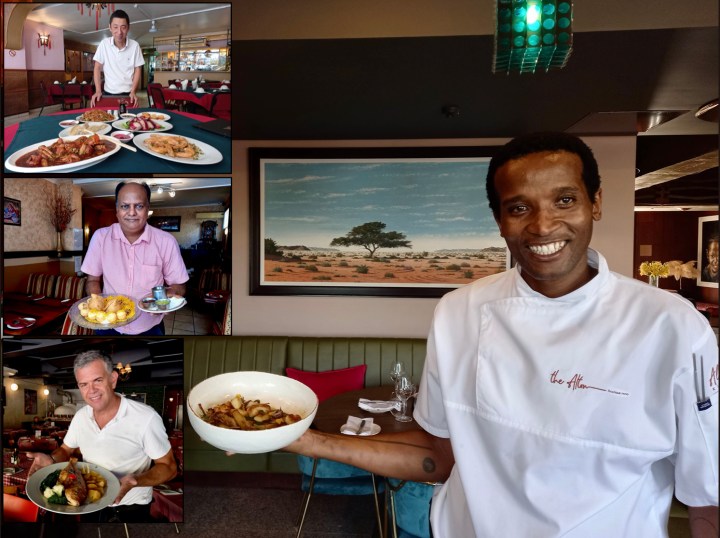
Ali Majija’s Albert’s Kitchen. George Hu’s China Plate. Tony de Sousa’s Al Firenze. Bimal Kanakia’s Bombay Blu. Diversity rules with Xhosa, Zulu, Chinese, Indian and Italian options. Finding them is the challenge. And what about the rugby?
The greatest secrets are always hidden in the most unlikely places, Roald Dahl wrote. One can but hope the woke folk rewriting his rascally celebrated texts won’t find this quote indigestible. Because it perfectly sums up the chefs, the flavours, the multisensory experiences created in the kitchens of the four eateries we feature here. Globally and locally inspired hidden gems, more than secrets, secreted away as they are in suburban Durban North. Word-of-mouth finds, as the best places in KZN often are.
Whether you’re reading this in Durban North, Darwin or Delhi, you most likely will not have heard of Albert’s Kitchen or the art-filled Alton boutique hotel, home to the contemporary fine-dining restaurant with creative twists. Both are scheduled to open as this issue of TGIFood publishes. Head chef at Albert’s Kitchen is the magnetic Ali Majija whose kitchen magic story embraces a cooking contest, Xhosa roots, stints in the kitchen at SA’s best restaurant. Plus wit, mirth… and rugby.
By contrast, China Plate team George and Jessie Hu have been cooking up authentic Shanghai flavours and spicier Sichuan fare at an out-the-way spot not too far from the quiet neighbourhood location of the Alton for 24 years and counting. Their fan base ranges from the city’s China embassy to greater Durban’s across-the-board melange who come for their brought-to-the-table-sizzling chicken and prawns, pork platter or bean curd; their Sichuan-style spicy chicken wings, beef with chilli sauce and stir-fried lamb; their playful deep-fried ice cream.
Another pukka long-established fave, like a needle in the haystack to find, is Bimal Kanakia’s Bombay Blu. He opened at this spot, within the ambit of one of Durban North’s two “culinary streets”, 12 years ago. This after the transplant from Mumbai had already been wooing tastebuds with quality, delicious, authentic and creative Indian fare in partnership ventures for at least that long. Excellent tandoori, Goan curries, and a large menu where the focus is fresh, quality, unpretentious good value.
Our final true original sees longevity, popularity and honest-to-goodness delectable Italian flavours continue to entice 30 years after Al Firenze opened and 15 years after genial and hospitable Tony de Sousa took over. I have had to use a map (now my GPS) every time I’ve arranged to meet someone at his inviting trattoria set near no other eateries in a quiet residential neighbourhood. De Sousa says his passion for the culinary was forged when he was a kid. His Durban-Portuguese (Afro-Portuguese, he calls it, citing Angolan and Mozambique influences) aunts and uncles were key to food being at the centre of family dynamics. For the past 15 years, an Italian kitchen has been his focus.
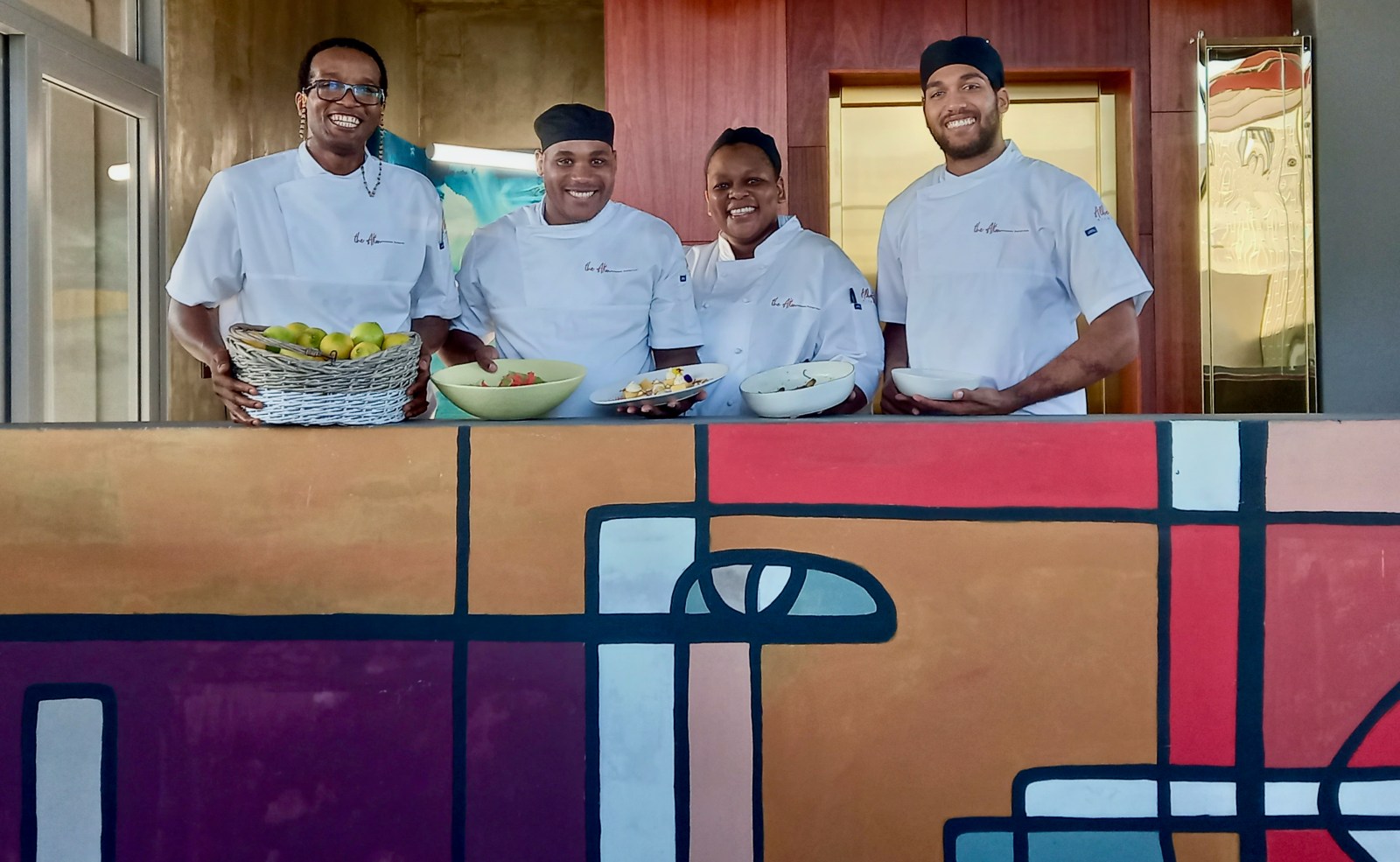
Chef Ali, left, with his Albert’s Kitchen team, chefs Mxolisi Mbambo, Nonhlanhla Madlala and Liam Gerber in The Alton atrium, mural by Ewok. Garden lemons for limoncello and sorbet. (Photo: Wanda Hennig)
First, to set the scene for Albert’s Kitchen and Chef Ali, a little about The Alton Boutique Hotel, to give the full name. I learnt of it from Chef Kayla-Ann Osborn, who I had seen was looking via social media for chefs and kitchen staff. So I messaged her to ask, what’s going on? Turned out she was consulting for The Alton. Suggested I might like to meet the new chef. And would I like to come in and check out the hotel that was on schedule to open.
So I found myself being shown, by manager Claudia Gerber, through this interesting collaboration between her dad, owner Allan Gerber, long in construction and property development, and Durban architect and furniture designer Richard Stretton, who in 2021 won a top award from the SA Institute of Architects for his Dukkah Restaurant design. “I saw Dukkah and loved it and that is why I approached Richard,” Gerber says.
The building, the furnishings, the entire art-filled space, Gerber worked on with Stratton, envisioning it as a homage to all things Durban in Durban North. The artwork and photography were selected to reflect Durban. Ditto, the menu.
Chef Ali had interned under Osborn at the Chef’s Table in Umhlanga. She suggested he check out The Alton and its planned restaurant, Albert’s Kitchen. The Alton is named for Gerber’s late son, who was a chef. Albert’s is named for Gerber’s late grandfather.
You may know Chef Ali Majija, the new kid on the butcher’s block, from his entrée into the food game, was headed for potential rugby stardom way back. The talented loosehead prop had soared into Sacs on a mixed rugby and academic scholarship. Soon his sights were set on Sevens. But life can change on a hip swivel.
“What kind of broke my rugby career was in my matric year I tore my anterior cruciate ligament. I had Tim Noakes as my doctor. He put me through an aggressive rehab to have me ready to go play again. But what happened, my heart was no longer there.” Majija drops rugby names, musing about what might have been.
“And so I just gravitated to my books. And from there, my scholarship from SACS was extended to UCT.” He graduated with a BCom majoring in accounting and stats, “which came very easy to me”.
While still at school he and a friend ran a rubble removal company. With his degree and needing a job, he went to work with his brother in the Cape Town model agency business. He did well setting up portfolios, working with photographers, booking extras for movies, commercials, shoots. Then managing models. Making quite a bit of money for people. But the industry and the exploitation he saw got a bit toxic.
He quit with no real plan but with a long-time girlfriend in Durban. And besides having loved being in the kitchen since he was a kid, this is where things were set in motion, poised, to cook.
Savour, if you will, this diversion into our three long-time culinary stars. Then back to Chef Ali.
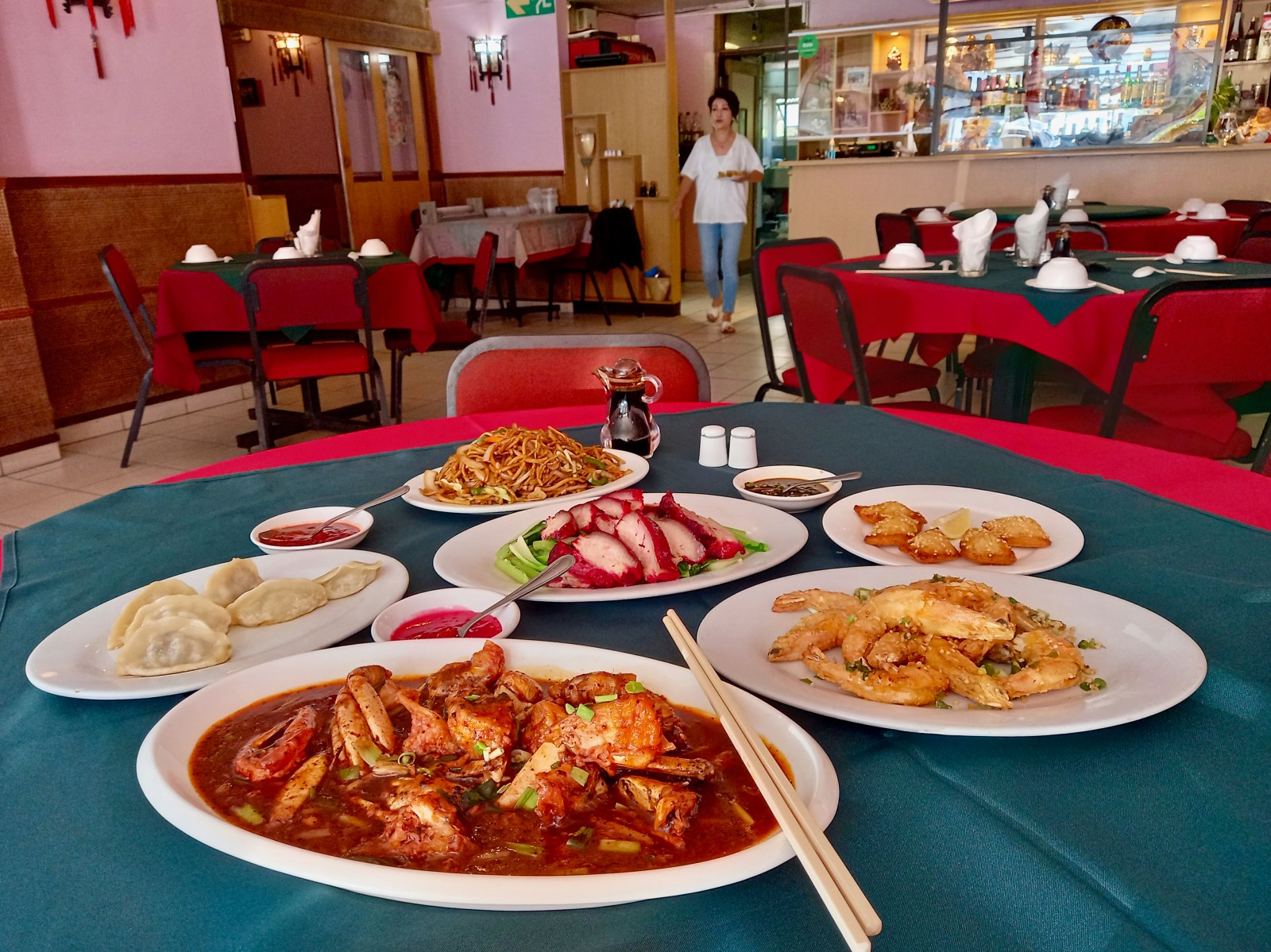
Jessie Hu brings a veggie dish to add to this China Plate spread of Shanghai and Sichuan deliciousness: chilli crab, crispy prawns, starters of sesame prawn toast and pork dumplings, barbecue pork and at the back, chow mein. (Photo: Wanda Hennig)
The first two foodie friends I ask to share their favourite Durban North restaurant, both the retired judge and a retired food writer, affirmed my inclination to write about China Plate. I had some trepidation arriving unannounced to introduce myself and connect with Jessie and George Hu, having read Chef George can be tetchy and short. Well, not always so. And I wonder if, when he is, it is not circumstances similar to those that infamously drove Enrico Ferrari to arms. (Read on for more.)
George, after chef school in Shanghai, worked at a top hotel there. Then, an adventurer at heart, when he had an opportunity to go cook in Nairobi, he went. Spent six years there. Along the way, returning to Shanghai to marry his delightful wife and business partner, Jessie. After one year back in Nairobi, with her, he allowed himself to be headhunted to Durban. The Edward Hotel in its five-star heyday and the erstwhile Mandarin Room.
After seven years at The Edward, he and Jessie opened China Plate in an unassuming off-the-track little strip-mall centre I’d challenge anyone to find who does not have directions and intent. Far more so 24 years ago when they opened. Before which, maybe only the pair of them knew it existed.
Then, as now, George’s creative, authentic Shanghai and spicier tweaked Sichuan menu entices a fervent and diverse fan base, including Chinese Embassy staffers when they want to impress contacts with the real deal. For instance, their strictly Chinese options like the seaweed salad and cucumber salad they don’t make for anyone non-Chinese unless asked.
The Sunday of my mid-afternoon unannounced arrival, after regaling me with stories from their past, Jessie disappears to the kitchen, brings back two little packages, one with a prawn spring roll, the other with a chicken spring roll, which I must eat soon as possible with sweet chilli dip. (Best spring rolls I remember eating, if you’re wondering.) She has asked me to come back two days later, after the lunchtime rush, to photograph some of the speciality dishes.
Who knew that two days later, within minutes of my getting there, plates would begin to appear and soon the table would be groaning. Orange crab cooked in black beans with ginger, spring onions, their own chilli sauce. “Only George make!” Jessie says with delight. The crispy sautéed garlic prawns. The barbecue pork belly, cooked in rice wine for four to six hours until tender, then dried in the wok and sliced to order. “Only George make!” The chewy, dense, sesame prawn toast starter. The wonderfully chewy pork and chive dumplings. The in-house-made noodles chicken chow mein. “Only George!” All of them.
“Chinese people, good to order lots, sit down and share. How we do it,” Jessie tells me. She brings more food. The “for vegans” cauliflower-and-broccoli deep-fried battered veggie dish. “Like tempura but my recipe,” says George. I take more pics.
Then he seats me, he and Jessie seat themselves and – delightful surprise – what has come out of the kitchen, we must all share.
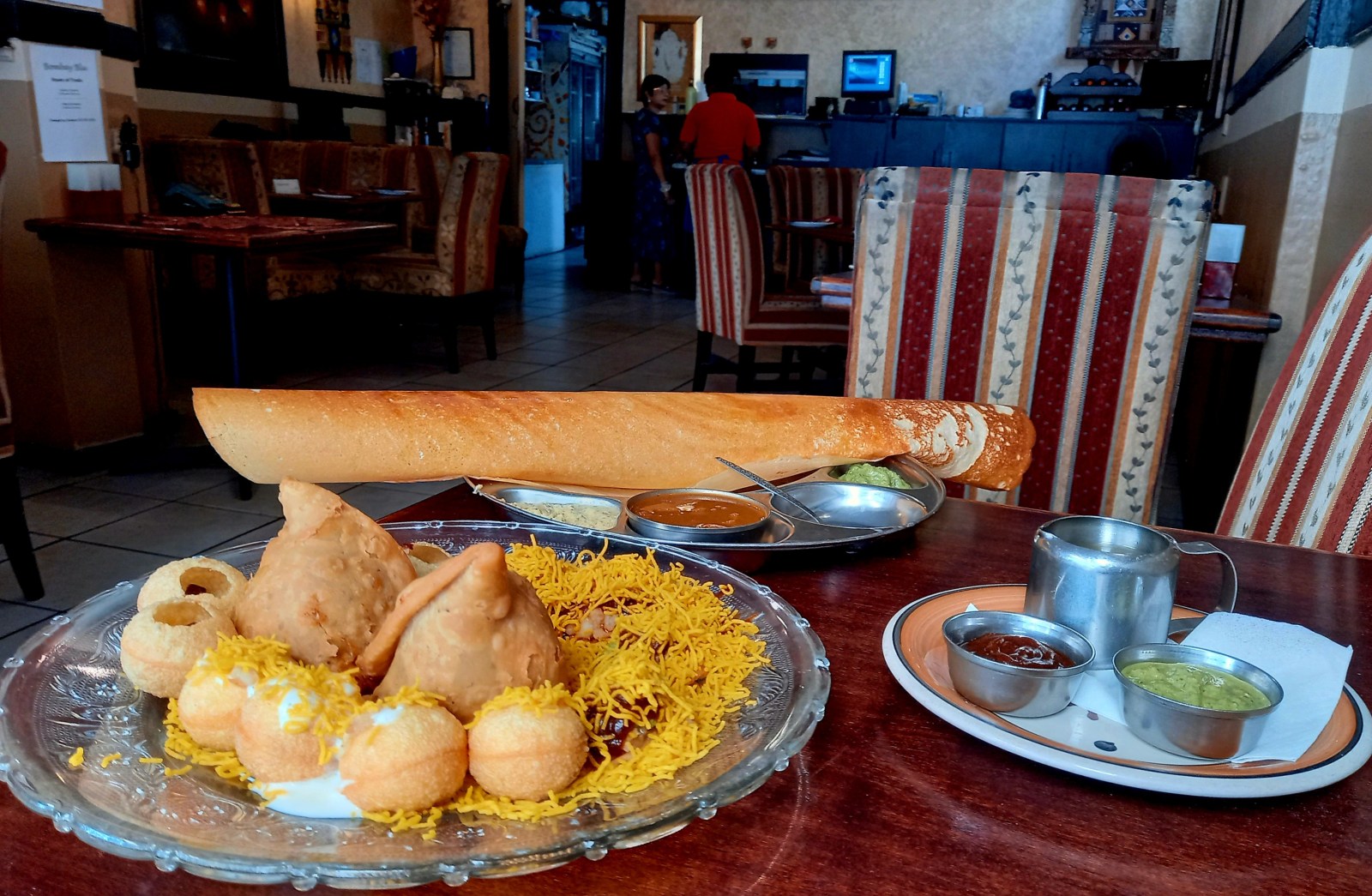
A Mumbai street food starter to share with pani puri, sev puri, dahi batata puri and Punjabi samoosas at Bombay Blu. Plus one of their eight dosa options. (Photo: Wanda Hennig)
Open wide, I tell myself. Not quite getting that “in the dentist chair” feeling. Because this is more fun. More delicious. And I see why I must open wide because when I opened in more delicate fashion and bit into my dahi batata puri, the little hollow-shell ball of crispy-fried semolina collapsed so there was more potato and tangy yoghurt with a touch of chilli from the mint sauce on my plate than in my mouth. Opening wide, getting the whole golden orb with its contents in at once, works better for the fusion of textures and flavours. How it’s meant to be done.
Bimal Kanakia, a delightful man who messages me after I’ve left to ask me to please let readers know he has 25 vegan items and anything can be made without onions or without garlic, came to Durban from Mumbai more than 25 years ago. We sit to talk in the outdoor section of his restaurant.
The menu’s “Bombay chat” aka Mumbai street food, including what I just ate and the pani puri, which has tamarind date inside and you pour in the mint water and eat in one bite. Plus eight dosa options. All are among his specialities.
And there are more surprises to find in such an unassuming place. Kanakia has three chefs cooking at any one time, brought in from India on contracts. A South Indian speciality chef. He mentions Bangalore and Kerala. A North Indian chef. He mentions Kashmir. And a Mumbai chef. They use 200 kg of tomatoes and 200 kg of onions a week at his two eateries (he has a second in Sunningdale). Tomatoes and cashews, and onions and cashews, are staples. For the lamb dishes, they use only deboned leg. And butter to cook. “You will never see oil floating, as you do with Durban curry,” he shares.
Rising food and specifically veggie prices are challenging but he’s afraid to put his prices up knowing everyone is battling, choosing to try to keep his existing customers happy.
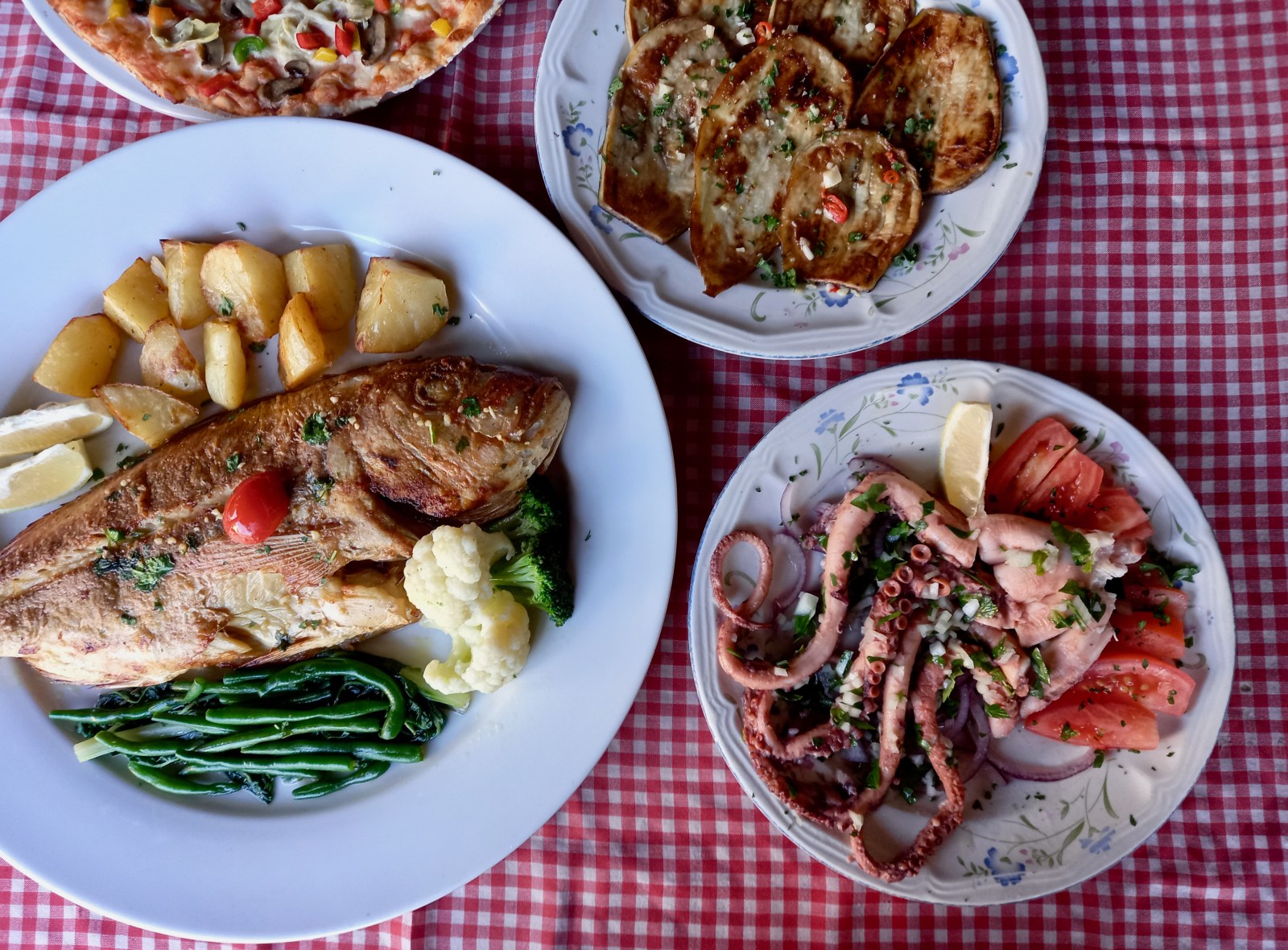
Al Firenze specialties from Tony de Sousa, grilled fresh market fish, Enrico Ferrari’s secret recipe luscious garlicky eggplant starter and flavourful Pacific Ocean octopus. (Photo: Wanda Hennig)
Social media wasn’t recording one’s every move for posterity back in the day the late “opinionated and bombastic” Enrico Ferrari was cooking up an Italian culinary storm at his celebrated Villa d’Este restaurants (first Gillespie Street, then Glenwood). He was legendary for his che buono! Italian fare. Notorious for his customer intolerance.
“So much goes into the prep, into the dishes. Enrico set the bar on Italian food. He was so passionate.” Why, says Tony de Sousa, customers who didn’t get it, but no doubt thought they had it, made Maestro Enrico so upset.
Ferrari had retired by 2009 when De Sousa, more familiar with the Portuguese restaurants of his roots, took over Al Firenze from founding Italian owners, Mirko and Doreen Nizzi, who returned to Italy. Ferrari came out of retirement, “joined me for five years, till he passed away. We cooked together every morning, 9 to 12. He taught me all his basic concepts, his sauces, his techniques. How to prep. How to perfect. His speciality dishes.”
The grilled eggplant starter is one. Thinly sliced aubergine, crispy near the skin, meltingly luscious in the flesh, garlicky with a hint of chilli. “Italian white vinegar, salt and pepper; Enrico’s secret recipe.”
“Impossible to replicate,” says Anne Stevens, Durban’s preeminent food critic for years till she retired from writing. Though not from passionate cooking and experimenting in her home kitchen. And testing out new eateries in Durban North and Umhlanga, making sure she doesn’t miss the gems. Revisiting her favourites. Al Firenze, Bombay Blu and China Plate are still high up there on her list.
“The menu is much the same as when Enrico was here.” With a lot more seafood added. And octopus about eight years ago after De Sousa went on holiday to Europe, ate it from Mediterranean menus and saw how it would fit on his. “It’s Pacific Ocean octopus. We get them from Cape Town. Steam them for more than an hour in white wine and white onions to soften. Olive oil, celery, green pepper, salt and pepper…”
He brings me a small bowl of chunks cut from tentacles I’ve photographed. A little chewy, as one expects. The kind of flavour that keeps you eating way beyond that moment when you know you’ve had more than enough.
De Sousa was born in Durban North. He’s local, from the neighbourhood and a friendly people-person. Attentive to customers who’ve been coming for years, given that 80 to 90 per cent are repeats. Equally attentive with guests who don’t know the food. “You have to educate people who are not sure about what they’ll get. A lot of people are on a budget. They want to come and have the experience of eating out and trying and enjoying the food. You have to suggest what they might enjoy, make sure they’re comfortable.”
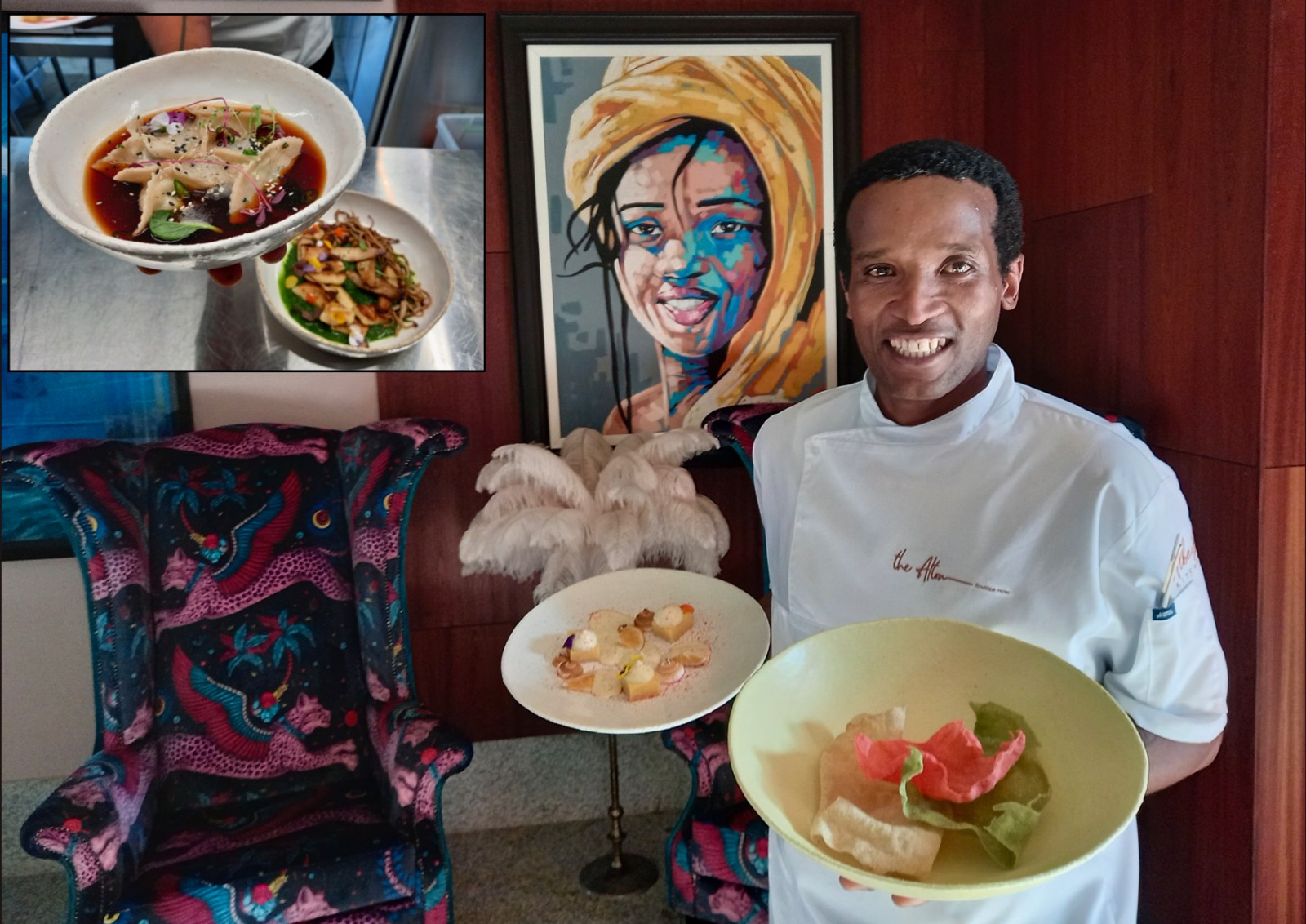
Albert’s Kitchen Head Chef Ali in The Alton lobby with his in-house made samp and bean, coriander rice and beetroot rice chips, used as tasty garnishes. Inset, a consommé with dumplings and a mushroom main.
At this point, let me share that I have been wanting to write about Chef Ali since I saw him, via Instagram, doing Xhosa-focused pop-up dinners using Durban’s Glenwood Bakery Bagels as the venue. I went along briefly to the first one. Met him. Realised there wasn’t enough yet to write about. Stayed in touch.
“What did you say his name was?” I ask Osborn before I head out. “He says he knows you. You wanted to write about him.” Aha. The penny drops. Thing is, though, I knew very little about Chef Ali. And his story? Tell me it’s not a delight.
He had given up the agency game. And the Xhosa-born Cape Town guy had this girlfriend in Durban he would commute regularly to see.
The Christmas of 2016/2017, he and his girlfriend “now my wife” decided to do Christmas lunch. “My wife’s family. They live here. They are Zulu, some Xhosa. Dating was pretty tough culturally. I had met the mom a couple of times but I had never really met the dad, except once, and that was very rough. They were having a braai, I was invited over, the dad had apparently gone to get beers. When I sat, I sat next to his wife, in a chair. So as I stood up to greet him, it was a very cold greeting. His words of exchange were, ‘You’re sitting in my chair.’”
So they did Christmas lunch. “A whole spread, a mix of Xhosa and Zulu from umleqwa (hard body chicken), steamed breads, then we made liver pâté basically using everything from the intestines of the umleqwa chicken. Then the beetroots, the coleslaws, the potato salads, the boiled meats. I also make a great cheesecake, so I made a dessert. So a mixture of my food, Western and all of that.”
Fast forward, “I go back home, I’m sitting in Cape Town, I get a WhatsApp message from the mom. My wife’s mom, now my mom-in-law. Nothing else, just a link. When I click on the link, it’s a cooking competition.
“She never said anything about the lunch. So I thought, hmmm, maybe they liked my food, and now this is a test. So I took up the challenge.” Talking with him, you get the sense that humour is always bubbling.
It was the KFC Taste Kitchen challenge. “They wanted basically to introduce more authentic, like, traditional things that are relatable to the market. The Asian markets have noodles, that sort of thing, incorporated within the KFC meal. So I think the SA market wanted to do something similar and basically they were looking for home cooks to try and find this and I was a home cook at the time.”
He had moved to Durban by the time the contest started. The audition called either for a pair or if someone entered single and got through, they would be paired with another contestant. His girlfriend’s mother and her sister urged her to go with him. “She was like, ‘I don’t cook’.” They were like, “Go and support him! And imagine if he gets through and is partnered with someone and there is no bond.”
For his audition dish, “I made a kind of chakalaka Chelsea bun.” His own red beans with the tomato cooked in, then the whole chakalaka base, onions, peppers, carrots. “Let it cool. Kneaded the dough, rolled it out, spread it with the chakalaka, rolled it, cut it into rolls, let it proof, baked it.”
Then, he used store-bought yeast. Now, after working for a stint in the kitchen at The LivingRoom with Chef Johannes Richter, “He taught me how to make a starter.” Since then Majija has used his own and believes he got the Chef’s Table internship thanks to the bread he baked using the starter he perfected.
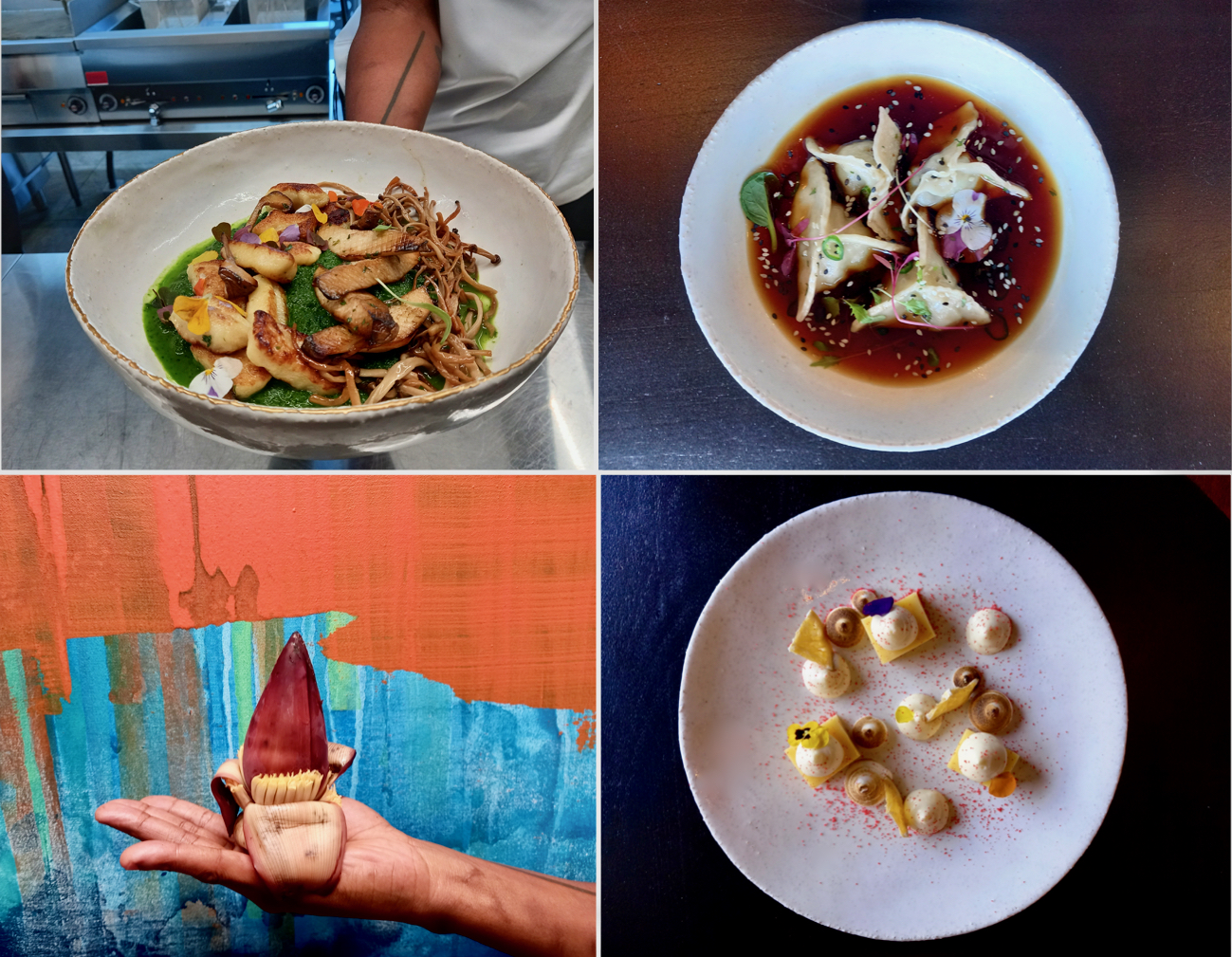
Clockwise from top left, three kinds of mushrooms have made their way into this legacy dish; a fish consommé with market fish dumplings; deconstructed cheese cake from pastry chef Mxolisi Mbambo; a banana blossom, which will transform into a creative homage to Durban. (Photo: Wanda Hennig)
As he has developed as a chef, among other things, Majija has been committed to broadening his cooking style and using fresh and innovative approaches, leaning more into the food and the flavours he grew up eating.
Back to the audition. “So afterwards I talk about the whole thing in front of the panel of judges. Then they go to my girlfriend, ‘You’ve said nothing, pretty much. What did you do?’
“She says, ‘Well I drove him here and I was up all night just chatting, keeping him company.’ They laughed about it.” He laughs about it too.
In brief, they find themselves short-listed. “We’re told we have to go see a psychologist for a whole lot of psychological tests. Basically, are you sane enough to be on TV?” Laughter.
They pass. “And this part is like where the torture was. We were bused to Joburg. Cooked for six weeks, shooting at night from about 8pm till 1am at a cooking school, then back to our accommodation to shoot diary entries and to sleep. People getting eliminated on a daily basis.” By now his then-girlfriend was cooking too.
They made it to the finals, at Emperor’s Palace. “Our winning dish basically had to be something that represented you. So I made like a bread biscuit and shaped it into a bowl. Inside was a curried butternut soup with koftas (spiced meatballs).” Coming from Durban, this represented the history of people who came in boats and the idea was also a play on bunny chow, “the vessel for the food that could also be consumed”.
They had to plate their dish for 10 people. And were announced the winners. “We were millionaires. Really. KFC gave us a million.”
After that, he went first to my mom and said, “I’ve found the person I want to have a baby with.” His mom said, “Well best to marry her before you do that.”
Then he called his uncle, said they needed to go speak to the dad, ask him about marrying his daughter and discuss labola. Professionally his wife, Nosizwe Mji Majija, currently studying psychology, is into health and wellness. She is also a yoga teacher, trained in Rishikesh, India.
Meanwhile, they took a holiday. “My now-wife and my wife’s sister, who is also the one who connected us so we call ourselves a crew. As a gift to her, we said, ‘you can come’.”
It was an East African food tour. Uganda. Kenya. “Then a flight to Tanzania. The greatest experience. Zanzibar, the food was like something I’ve never seen. It’s a Muslim country but there is alcohol and it’s tropical. So they’ve got fruit juices, for like days… We’d go to a place to eat and their juice bar, major fruits and unbelievable variety and things like green oranges that are yellow inside. And we went to a spice farm. Just going through the stories of spices. It’s crazy. And very much at the same time, so humble. And the sustainable living. It was really great.”
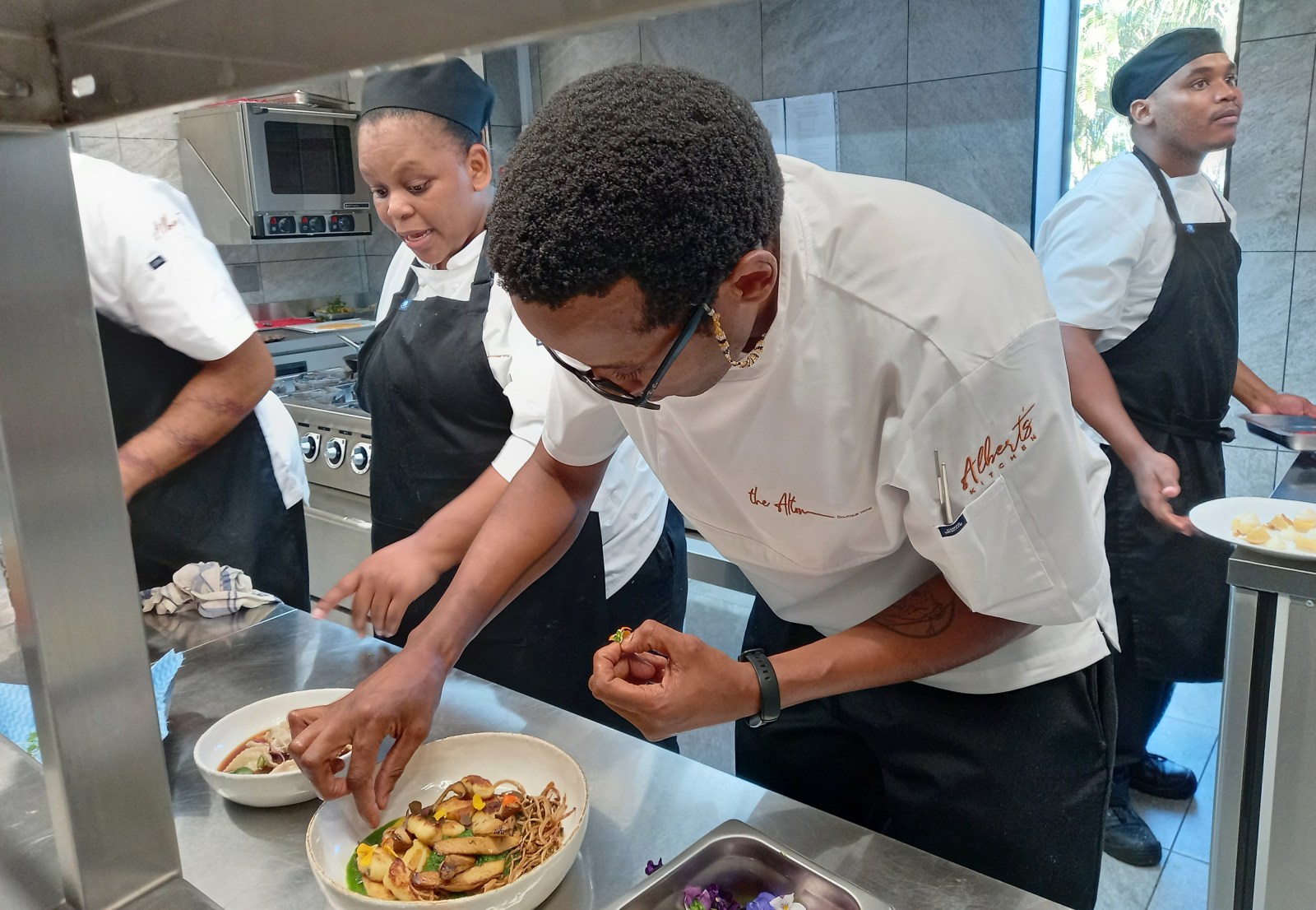
Chef Ali plates a serving of his innovative Xhosa-childhood-inspired mushroom and spinach legacy dish. (Photo: Wanda Hennig)
In Albert’s Kitchen, they have been carefully preparing the basics of a menu, which will change, and making sure it will be deliciously executed. “Creating a recipe book, too, of standards. And the kitchen team, we have been sharing our food memories. Creating dishes from them. Also researching plating techniques. Planning for eventualities.” He says he has been using some of his old rugby passing techniques to practise how they can all work well together and pass each other in the small kitchen.
Chef Ali prefers not to label his food, which can set up expectations that may not be accurate. His use of banana blossoms, for instance… His memories of Durban incorporate bananas. As a kid, he had a T-shirt with bananas. Also, he sees using bananas as paying homage to the Indian community. To this end, he has worked on a dish using oyster sauce, marinated lime, lemon, chilli, tempura, the result of which is a textured fish substitute great for vegans.
When growing up, he says, mushrooms and spinach were staples. From this inspiration, he has created a wild mushroom dish. Elevated it by making a kale and spinach purée then rehydrating shimeji mushrooms using a fermented tea of rosemary, mint, rooibos and sugar, no scoby. There are also smoked oyster mushrooms and shiitake mushrooms, delicate flavours and beautiful plating. Also a fish consommé with dumplings and chilli, which speaks to him of Durban. “Our market fish, chives, garlic, onion, fennel, coconut cream blended…”
After the contest win, Ali went knocking on doors looking for a kitchen apprenticeship. No luck. “People would look at these hands and they’re not kitchen hands,” he laughs. More than that, there was the long CV with no kitchen experience.
“Luckily my wife’s family were close with Johannes Richter’s mom at Summer Hill. She was at their place for drinks one evening and mentioned I was looking.” It was long before Richter won best South African restaurant and things were relatively quiet. “Johannes invited me to come in a couple of times a week to work under his guidance, prepping, prepping, prepping. It was before Covid.
“When we were having a conversation one day, Johannes’s view was, if I wanted to work for myself, looking at my age, I could probably just do it. But if I wanted to work in a kitchen, it was best to get a culinary diploma or degree so I would have credentials.”
So Ali started investigating, found the International Hotel School, which had a two-year diploma in culinary arts trainee programme, where you are placed somewhere while you’re studying and come out with two years experience as well as your diploma. He applied to Chef’s Table in Umhlanga, which wasn’t on their list of placements. “I think I was privileged in terms of my age,” he says.
He interviewed with Chef Kayla, who was still there at the time. Negotiated a stipend. Baked bread using his own starter. And within a couple of months, was given a Chef’s Table uniform to replace the “trainee” one. “Which fuelled my confidence. I felt, I can do this, as in what I wanted to achieve. That my drive, my past experience, everything could come together.” Fast-forward to where he is now. Seems it has. DM/TGIFood
Follow Bombay Blu on Facebook and on Instagram. Follow The Alton Boutique Hotel on Facebook and on Instagram and Chef Ali ‘SoSo’ Majija on Instagram. Follow Al Firenze on Facebook and on Instagram. See the China Plate website.
Follow Wanda on Instagram wanda_hennig




I want to eat the lot. Appetisingly well written!